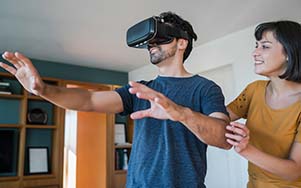Immersive Technology
Immersive experiences, interactive environments, and cutting-edge digital solutions.
Immersive Technology Solutions
We create immersive technology solutions that transform the way people experience digital and physical environments. From virtual and augmented reality applications and real-time 3D simulations to training environments, interactive experiences, and location-based enhancements, our immersive approach helps organizations engage audiences, enhance learning, and unlock new growth opportunities.

Immersive Technology Solutions that Drive Business Forward
Immersive Technology combines virtual reality (VR), augmented reality (AR), and mixed reality (MR) to create interactive and engaging digital experiences. From virtual training simulations and 3D product demonstrations to collaborative workspaces and immersive storytelling, our solutions help businesses captivate audiences, enhance learning, and deliver memorable experiences that drive innovation and growth.
Immersive AR & VR / XR Development Services
Immersive technologies merge the physical world with digital or simulated realities. AR overlays computer-generated information onto the real environment, while VR creates a fully immersive experience using computer-generated content. Unlock immersive AR, VR, and XR experiences with custom-built software designed to engage and delight. Our team specializes in developing end-to-end virtual reality, augmented reality, and mixed reality solutions—integrating cutting-edge tools like Unity, Unreal Engine, 3D rendering, spatial tracking, and AI-powered features.
-
VR & AR Applications
We design fully immersive VR & AR applications across devices—headsets, mobile, tablets—whether you need product try-ons, training modules, interactive experiences, or real-time visualizations. -
Mixed Reality Solutions
Craft MR systems that blend the virtual and real world with environment mapping, gesture-based controls, and dynamic content overlays for surgical precision in industrial, healthcare, or safety applications. -
3D Visualization & Spatial Tools
Build 3D visualization platforms and spatial tools that allow users to explore environments in 360°, inspect products, or analyze complex data sets in realistic, immersive contexts. -
AI Enhanced Features
Use computer vision, machine learning, predictive analytics, and natural language processing to power smarter AR/VR experiences—voice, gesture, image recognition—all working seamlessly inside your immersive environment. -
Industry-Specific Ranges
Tailor immersive solutions for industries such as healthcare, e-commerce, education, entertainment, real estate, manufacturing, and beyond—each with its unique challenges and opportunities.
Why Choose Our AR / VR Services
-
High-quality immersive design for realistic visuals and smooth interactions
-
Reduced risk for training, prototyping, and product testing via virtual simulations
-
Enhanced customer engagement through experiential marketing and product visualization
-
Scalable solutions with continuous support, updates, and performance optimization
Augmented Reality (AR) Overview
AR utilizes processors, displays, sensors, and input devices to create interactive experiences. The article outlines four types of AR:
-
Marker-based AR: Uses visual markers, like QR codes, to trigger digital content.
-
Markerless AR: Employs GPS or sensors to provide data.
-
Projection-based AR: Projects artificial light onto surfaces.
-
Superimposition AR: Partially or fully replaces the original view with a new one.
Virtual Reality (VR) Overview
VR systems use head-mounted displays and input devices to immerse users in virtual environments. The article describes three types of VR:
-
Non-immersive VR: Stimulates only a subset of senses.
-
Semi-immersive VR: Engages more senses but not all.
-
Fully-immersive VR: Stimulates all senses for complete immersion.
Industry Applications
Immersive technologies are applied across various industries:
-
Healthcare: AR headsets assist surgeons by visualizing patient data during operations.
-
Education: AR enables interactive learning experiences.
-
Marketing: VR allows consumers to interact with products virtually.
-
Defense: VR is used for training simulations; AR aids in battlefield mapping.
Challenges and Future Outlook
Despite advancements, challenges remain, including:
-
User experience issues due to bulky hardware.
-
High costs of content creation and hardware.
-
Privacy and data security concerns.